Winter Is Here! Which Vibrams Shall I Wear?
PLEASE NOTE –
We’re seeing a massive shift in the barefoot shoes that people are buying. The days are getting shorter, it’s colder, it’s wetter, and its windier. People are seeking out the best Vibram FiveFingers for winter – and we’re here to help you find the perfect choice.
An Overview
In case you don’t want to read the whole article, we’ve made it easy for you to pick out the best shoe depending on what activity you’re likely to use the shoes for most:
- The undisputed winter shoe: Bikila Evo WP
- General winter shoe / Good all-rounder: Trek Sport
- Mild winter running: Trek Sport Sandal
- Mud Obstacle Events: Spyridon MR
- Water-resistance: Lontra (please be aware, the Lontra is being discontinued)
- Hardcore winter running: The Trek Sport or Spyridon with some decent toe socks!
…But if you want to know more, read on!
A Quick Look at the Soles
Vibram Fivefingers have some excellent styles that are designed for use in colder weather and challenging terrain, but there are two sole types that stand out as the most winter-proof; the Trek sole, and the Spyridon sole (aka the Vibram XS Trek compound).
The ICETREK Sole
The ICETREK sole is unique to the Bikila Evo WP. Built on the same style / shape of sole as the original Bikila Evo, except the sole on the WP is made from Vibram’s patented ICETREK technology. Not only has this rubber compound been granted full marks by Vibram for its durability, it is “developed to grant the best grip on very cold, iced, or snowy surfaces, VIBRAM® Icetrek allows you to move, work, and live safely on mountains and in cold areas.”

The ‘Trek’ Sole

The Trek sole can be found on the following styles:
With a maximum sole thickness of just 7.5mm the Trek sole is very minimal – but in comparison to some of its peers (EL-X 3.5mm, Seeya 3.5mm) it is more ‘built up’, thus giving less ‘barefoot feel’ (aka proprioception / feedback).
The extra sole depth comes in the form of tread. The lugs on the Trek sole are strategically placed to provide extra grip where it is needed, giving you confidence when running on the trails. The extra sole thickness means the Trek sole is less flexible than other Vibram styles.
The Vibram XS Trek Compound Sole

The Vibram XS Trek Compound Sole is found on the Spyridon MR.
The Spyridon MR sole is more minimal than the Trek sole with a maximum sole thickness of just 4mm. The sole features multi-directional tread designed to provide traction and stability when you need it most. The Spyridon MR sole is also much more flexible than the Trek sole, and you can easily roll and flex the sole.
A Look At The Shoes
Bikila Evo WP: The ONLY Waterproof ‘barefoot’ shoe
The Bikila Evo WP was released in November 2014 and has created quite a stir. For year, barefoot runners have been calling out for a shoe that is genuinely waterproof, and now we have it.
This shoe features a triple fastening mechanism: A concealed quick-lace system, a full zipper, and a Velcro across the top. The upper fabric is 100% waterproof, the zipper has taped seams, and the ICETREK sole is super-grippy in snow and ice. Despite the wealth of features, the Bikila Evo WP is also extremely lightweight. Its baffling how a shoe so good, so comprehensive, can remain so low on weight.
Buy the Bikila Evo WP
Trek Sport: Great for winter and year-round
The Trek Sport is one of Vibram FiveFingers’ most popular styles. The black/charcoal colourway is arguably more ‘socially acceptable’ and less conspicuous than some of Vibram’s more brighter, vibrant styles. The upper is exactly the same as the KSO (Keep Stuff Out) style, and the Trek Sport style and colour is exactly the same for both men and women.

Because the upper fabric completely covers the foot to just below the ankle, it provides warmth and does a great job of preventing any objects (gravel, sand, mud) from getting inside the five-toe shoe. The mesh ensures the feet can breathe and the Velcro fastening is a God-send when your fingers are cold; simply pull and stick – no fumbling with numb fingers to lace-up your shoes!
What is the Trek Sport best for?
These are all reasons that make the classic Trek Sport an ideal choice if you are looking for a shoe that will perform in:
- Boot Camps
- Off-road running (trail running, beach running,
- Mud obstacle courses such as Tough Mudder
- Trekking
- Day-to-day use
Buy the Trek Sport from Feetus.co.uk
Trek Sport Sandal: Great for trails in milder weather
Vibram released the Trek Sport Sandal in 2013 to very favourable reviews. While the original Trek Sport is great for hitting the trails when the weather is cooler, muddier, and the terrain looser – The Trek Sport Sandal will serve you better when it is warmer, and when the terrain is more hard-packed.
That said – You can provide extra warmth and protection by adding a pair of Injinji toe socks.
More a shoe than a sandal, The Trek Sport Sandal features vents on each side of the shoe providing incredible breathability. The upper fabric is extremely durable and comfortable.
While the Trek Sport is a Velcro-only style, the Sandal is lace-only (LS) and comes fitted with Vibram’s brilliant Quick-Lace system as standard plus a spare pair of conventional laces, giving you the choice of how you lace your Sandal.
What is the Trek Sport Sandal best for?
The Trek Sport Sandal is certainly less of a winter shoe than the Trek Sport, but is equally as versatile, making it a popular choice for the following activities when the weather is fairer:
- Off-road Running (Trail Running, Beach)
- Boot Camps
- Trekking
Buy the Trek Sport Sandal from Feetus.co.uk
Lontra: Water-Resistant and Thermal
The Lontra was the original winter barefoot running shoe – before the Bikila Evo WP was released.. The upper is water-resistant (but not waterproof), and is more padded than any other style, providing thermal qualities to keep your feet warm when it gets cold.
The Lontra features a multi-layer laminate upper with fully taped seams, providing insulation and water resistance. The micro pile fleece liner is soft against the skin while helping wick perspiration away from the foot. Other features include: a neoprene heel cuff to keep out snow and debris, a reinforced hook and loop closure for a snug and secure fit; and reflective surfaces for safety at night. The 4mm EVA midsole provides insulation from frozen surfaces, and the TC-1 Dura outsole provides traction, durability and superior plating protection.
The Lontra feels slightly over-sized, and I suspect it was designed this way to provide extra space inside the shoe to give the wearer the option of wearing toe socks for extra warmth and comfort.
You may also find the Lontra to be less breathable than other styles. This is arguably a fair trade-off given the water resistance element.
What is the Lontra best for?
You will likely find the Lontra best for you if
- You’re running when it is really cold
- Snow running
- Off-road running (unless it is warm)
- Boot Camps
- Obstacle events such as Tough Mudder, Mudderling, Spartan Races, etc
Buy the Lontra
The Spyridon: A viable winter option: Copes well in mud obstacle races.
The Spyridon MR is available for both men and women:
The upper fabric is only slightly water resistant (not as much as the Lontra). Like the Trek Sport and the Lontra, your foot is fully covered giving excellent protection against loose objects when running and preventing things such as stones, gravel and mud from entering the shoe.
The ‘MR’ in the name actually stands for Mud Runner and the shoe was designed for off-road, muddy pursuits; the grippy sole akin to that of a mountain bike tyre.
What is the Spyridon best for?
As such, the Spyridon MR will serve you well if you want a winter shoe that still has maximum barefoot feel, whilst still performs well in:
- Mud obstacle courses such as Tough Mudder
- Trail Running
- Boot Camps
Buy the Spyridon MR
A Personal Opinion / Conclusion
It has to be said that the most important aspect of keeping warm in a ‘barefoot’ shoe is not so much in the shoe itself, but in the socks you wear underneath. Without socks, your feet are really going to feel the cold. If you want to continue running and training outside in the colder months, don’t forget your socks!
See our huge range of toe socks
If you’re looking for a pair of Vibram Fivefingers for general use, for road running and for a bit of everything, there is no better product than the Bikila Evo WP. Unparalleled grip, waterproof, and the look amazing!
I personally find the Lontra to be a little too ‘clumpy’, heavy, and rigid. When I run in the Lontra, I lose all-important ‘barefoot feel’ (also known as proprioception, ground-feel, or feedback) and I notice that my running form suffers.
The Trek Sport and Trek Sport Sandal are two of my favourite shoes. Excellent handling, great for long distance, top breathability: I personally cannot find any faults with these shoes, though some may argue that the Trek sole is too thick at 7.5mm). I would argue that the tread depth is essential for all trail running / trekking enthusiasts.
The Spyridon MR, while being a very attractive shoe with what looks to be a very ‘grippy’ sole, I find it to lack the appropriate grip when the conditions get very wet. I also find that the Spyridon MR does not provide the level of breathability that is essential in a running shoe.
Don’t Forget Your Socks
It goes without saying that in winter, a pair of socks can make a difference between a great run, and a downright hideous one. It’s so important to keep the blood flowing in your feet, so make sure you keep your feet warm and comfortable. As soon as you lose feeling in your feet, how do you know if your technique is correct? …You don’t!

A pair of socks will go a long way to keep you dry, warm, and most importantly, running naturally. Specialist running shoes with individual toe pockets require specialist socks with toe pockets. Luckily, we have the best toe socks on the market… Injinji toe socks.
Pick up a pair of Injinji toe socks today.
Customer Questions
1. Brian Holden asked: “How will they [Vibram FiveFingers] fit with toe socks?”
By adding a pair of Lightweight Injinji toe socks, the added ‘bulk’ is so minimal that this will make no difference to how your FiveFingers fit.
Wearing Original Weight Injinji socks under your Vibrams will have a greater impact. If you Vibrams are currently quite close-fitting (i.e, your toes graze the end of your shoe), then the added material from the Original Weight socks will probably be too much, and could cause ill-fitting inside the shoe. This of course, will have a knock-on effect to your running performance and comfort.
Most people will find that, if you are usually a size 43 in a KSO, a size 43 Lontra will feel a little oversized, meaning you could easily accommodate a pair of Original Weight socks inside.

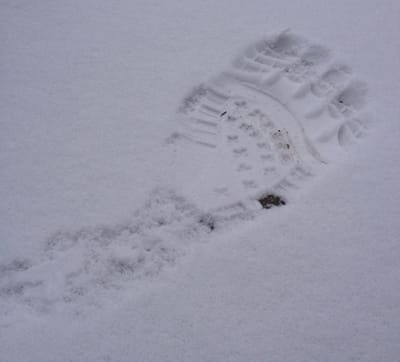
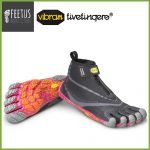

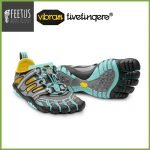
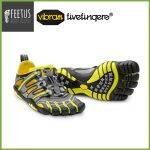
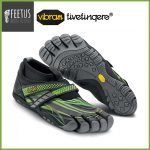

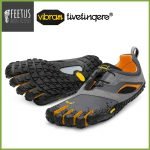
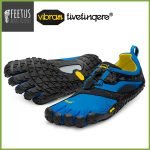
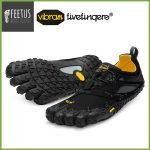





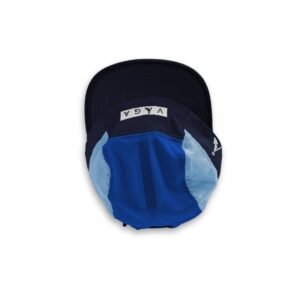 VÅGA Club Cap - Bluebird - The Original Short Peak Running Cap
VÅGA Club Cap - Bluebird - The Original Short Peak Running Cap
6 thoughts on “What Vibram FiveFingers Should I Wear In Winter?”
Hi Lee,
It realyl is quite fascinating how different we percieve winter footwear and you really did beat me to my own post on the subject, thus I will just add a few general comments.
Winter running is first and foremost about adaptation and slowly run into it as autumn turns to winter.
Speaking of five fingers my absolute favourite winter sole has been a suprise to me and is the one found on the EL-X, it is a very strong performer on ice,hard packed snow, and on bare rock faces. In deep snow I prefer the Spyridon, but the El-X is better on blank ice and on bare rock surfaces.
I have tested it last week down to -22C (chillfactor -31C) just last week both on and off trail. with lots of mixed winter conditions, lots of blank ice, lots of hardpacked snow, powdery snow and bare rock faces (with and without ice), the soft flex really is perfect when thibngs are a little slippery.
Temperature wise, I run my seeya down to -25C without socks on distances up to 25K and the spyridon with a thin smartwool toe sock (dotn tell anyone , but I prefer them over injinjis) easily goes below -30C.
I have never been a big fan of the trek sole as it is a very thick and rigid sole, that performs rather poorly on ice.
I do recon that arctic winter and British winter is quite different, so for trial conditions in the UK I have no clue
But my witner shoe update is on its way:)
Thomas,
Your input, as always, is valued greatly.
It’s extremely interesting what you say about the EL-X. As you know, this style was only released this year (2013), and we have had no snow or ice in the UK to test the EL-X on (yet!). I know the sole is deceivingly ‘grippy’, but I would have never expected it to cope well on ice and hard-packed snow.
Another factor is warmth.
Just this morning I did a short loop in my KSOs. Although the temperature outside was probably around 5 degrees celsius, already I am starting to think about hanging these up until March/April next year. Within the first 2km I was losing feeling in my feet.
The EL-X (3.5mm) is even more minimal than the KSO (4mm), and I quiver at the thought of taking the EL-X for a spin in sub-zero conditions, never mind -22C as you have.
It is certainly nice to hear a completely different perspective of Vibram FiveFingers’ suitability for winter conditions. Please do share your blog post on winter shoes when you have published it; I am very intrigued.
Best Regards (and PS; I will get in touch with Smartwool and see if we can bring in some of their toe socks).
Lee from Feetus.co.uk
Hi there i am kavin, its my first occasion to commenting anywhere, when i
read this paragraph i thought i could also make comment due to this sensible post.
These are in fact great ideas in about blogging. You have touched some good factors here.
Any way keep up wrinting.